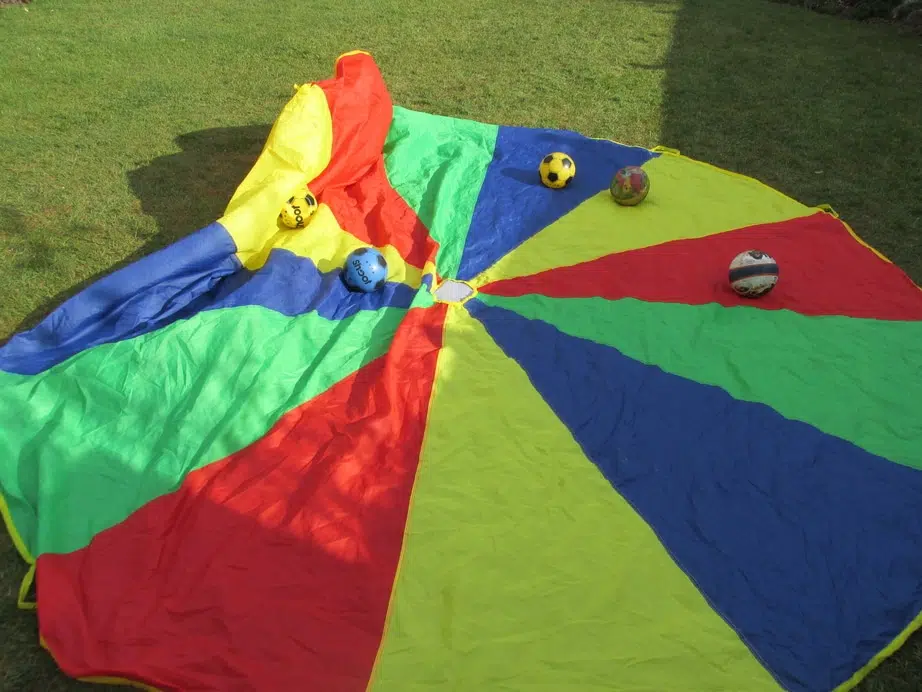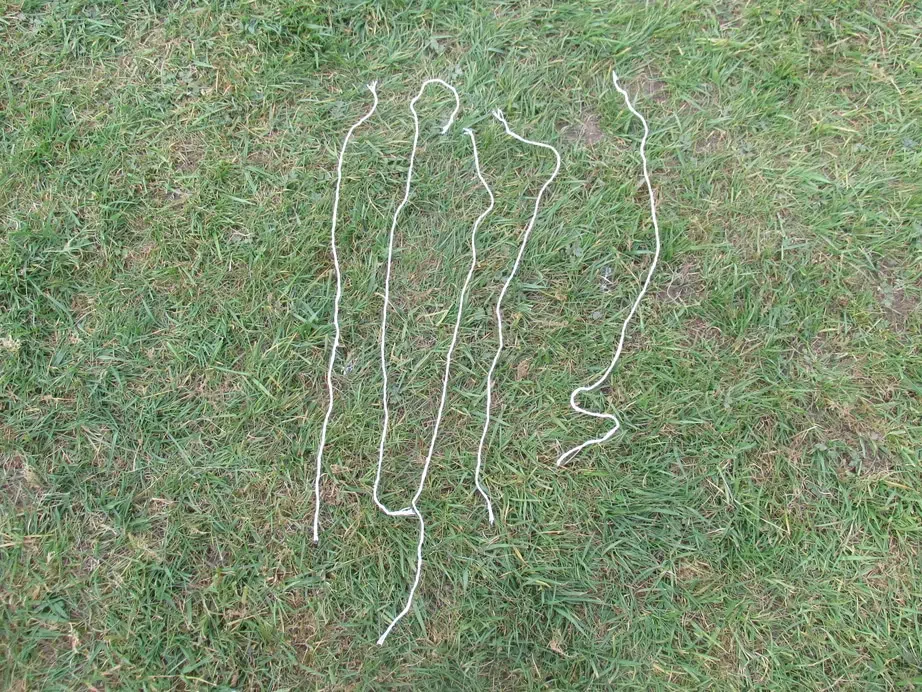Parachute games work brilliantly for kids of middle school age. They provide a fantastic
I’ve been a teacher for more than the last decade, and in that time I’ve tried hundreds of parachute games.
In this post, I’m going to whittle it down to the ultimate 19 parachute games for middle school.
Parachute games are fantastic for developing all sorts of skills, including math knowledge, literacy skills, physical development (source), coordination, cooperation skills, and teamwork.
Let’s dive into the games…

1. Catapult!
Here’s a really simple one to start with that they really seem to enjoy.
It is a fun team-builder. The kids stand around a parachute, holding it at about waist height.
Have a large sponge or rubber ball, and place that in the middle of the chute.
Then everyone goes, ‘1, 2, 3, Lift!’ The idea is to throw the ball as high as you can in the air. If you’re indoors, can you hit the ceiling?
2. Catapult Target!
This is the trickier version of the ‘catapult’ game above.
The kids stand holding the parachute with a large sponge ball on it. You also need a large ‘target’ on the ground near where they are standing. Something like a big sheet or tarpaulin would do the trick.
Basically, the kids will try to throw the ball up into the air and land it on the target. If they miss, they can discuss how close they were and refine their strategy.
3. Snakes
This is a quite bizarre game of cooperation that they seem to really like.
All you need for this is a parachute and about 6 or 7 pieces of string. The string pieces will all be roughly about 1 yard long. These are the ‘snakes’.
Throw the ‘snakes’ onto the parachute, with everyone holding it. Now the idea is for everyone to jiggle and wiggle the snakes around until they all form one big ball! I’ve no idea why this happens, but when they touch each other the strings get tangled up.
In the end, you have a ball of ‘snakes’!

4. Mushroom
Everyone starts by holding the parachute again for this one. You are all going to say, ‘1, 2, 3, Lift!’ And everyone lifts the chute into the air.
When it goes up, everyone keeps on holding it, moves forward in the circle, and crouches down.
The chute will billow down and cover everyone!
It looks like a giant mushroom.
5. Turtle
This is another fantastic game of cooperation and teamwork.
The kids are all going to crouch next to each other in a pack, and place the parachute over the top of the whole lot of them. They are the turtle, and the parachute is the turtle shell.
The kids are going to try to crawl around the space without the parachute coming off them! They need to try to coordinate in some way so that they are all going in the same direction. That way, the shell should stay well and truly on for all of them.
6. Fruit Salad
This is a classic outdoor circle game, that can definitely be tried with a parachute.
The kids stand holding the parachute. The adult will decide on four fruit names, such as ‘banana,’ ‘apple’, ‘melon’, and ‘peach.’
They will point to each child in turn and label each one of these four fruits. So, if you had twelve kids, you’d have three ‘bananas’ each standing at different points of the circle.
Then go, ‘1, 2, 3, lift!’ Lift the chute, and the adult calls out the name of one of the fruits – for example, ‘peach!’
All the peaches run under the parachute, and swap places.
Continue for different fruit names.
7. Roll Ball
Here’s another fantastic team-building activity.
Everyone stands holding the parachute at waist height. Have one large rubber ball on the parachute.
The idea is for everyone to work as a team to roll the ball around the outside edge of the parachute, but without it falling off. How many revolutions of the chute can you do without it falling off?
8. Roll Ball Competition
This is the competitive version of the ‘roll ball’ game above (as you probably guessed!).
Everyone holds the parachute again and split them into two teams by drawing an imaginary line down the middle of the chute. Everyone on one side is on one team, and everyone on the other is on the opposing team.
Use a large sponge ball for this game (for safety reasons).
One team is now trying to get the ball to travel off the parachute on their opponent’s side. And that team is trying to stop them, and get the ball to fly off the chute on the other side.
It’s a game of rolling and bouncing!
Whenever the ball flies off on either side, the opposite team scores a point. I usually play the first team to five points is the winner.
9. Pirate Pull
This is a game that mimics the action of oars being pulled.
Split the kids into two teams. Each team holds one end of the parachute.
Label one team as ‘number 1’ and the other as ‘number 2’. (Or you could label them something even more original if you really wanted!).
Either an adult or a child will be the ‘caller’. They call either ‘1’ or ‘2’. That side pulls the parachute backward in the manner of pulling on oars.
Then call out ‘2’. The other side pulls.
Continue like this – ‘1, 2, 1, 2’, with the kids pulling and pushing on the parachute backward and forwards.
10. Number Dive
This is a good game for learning any particular numbers or math concepts that you may be studying at that time.
If you were studying addition, for example, you would put some number flashcards on the ground under the parachute. These would be the answers to the forthcoming addition questions.
The kids all hold the parachute. Everyone goes, ‘1, 2, 3, Lift!’ And lift the chute up so that it balloons up into the air.
The adult will say a child’s name, and also give them an additional question. So, you might say, ‘Charlie. 11 add 7.’
It would be over to Charlie to quickly work out the answer, dive under the parachute, and grab the flashcard with the number ‘18’ on it.
It can be a good idea to give them some thinking time for this activity, so you could also pick the child and give the question before you lift the parachute up (to give them a fighting chance to work out the answer).
You can also do this activity with:
- Shapes
- Subtraction
- Finding more or less
11. Bounce Count
This is a great way of counting in different numbers.
Hold the parachute with a ball on it. Decide how you are going to count, for example counting in 2s, 5s, 10s, or other numbers.
Have a large rubber or sponge ball on the parachute.
Everyone cooperates to bounce the ball high into the air at the same time, and shout the first number in the sequence as it goes up – e.g. ‘5’ (if you’re counting in 5s). Next time you bounce it call out ’10.’
12. Team Tennis
You need two parachutes for this game, and one large rubber or sponge ball.
Split the kids into two teams, and they each hold one of the parachutes. The team will be standing about one or two yards away from each other.
One team has the ball on their parachute to start with. They are going to try to throw it to the other team, and they will try to catch it in their chute!
Then that team will throw it back!
Keep going like this, throwing the ball back and forwards.
13. Coconut Shy!
For this game, split the players into two teams again. One team holds the parachute, while the others line up a fair distance away from them.
Each player in the team lining up will have a sponge ball, and it’s good if you have a large supply of sponge balls on hand next to that team.
The first player in the lining up team is going to try to throw their sponge ball into the parachute! (like a coconut shy)
You can play this game in lots of different ways, such as:
- The two teams are working together. The parachute team is trying to actively catch the balls in the chute
- The two teams are against each other! The parachute team is trying to get out of the way of the balls that are thrown!
14. Coconut Shy! Time Limit
In this game, you need a huge number of small sponge balls – probably at least a hundred.
One team is holding the chute, and the others are throwing the balls.
Have a pre-agreed time limit, such as two minutes.
Start the timer, and the throwing team is going to all start launching sponge balls towards the parachute, trying to get them in.
The parachute team can move around to try to avoid the balls, but they cannot bounce them out once they’ve landed in the chute.
After two minutes, count up how many balls have landed in the parachute.
All swap roles and try the game again. The winning team is the one that throws most balls into their opponent’s parachute.
15. Bounce Count!
Split the kids into two teams for this game. One will be holding a parachute with a ball in it, and the others will be in a space nearby.
The kids that are not holding the chute will be given a task that they all need to complete together. It could be:
- Run in a relay from one end of the room to the other one at a time
- Do a circuit of exercises
- Do something like 20 star-jumps
Say, ‘Ready, steady, go!’ The parachute team will start throwing a ball up into the air on the chute and counting each time it goes up, starting at 1.
The others will be doing their task as quickly as they can.
When the task is finished, the parachute counters will stop. Take a note of the number they have got to.
Then it’s time to swap roles. The idea is now for the kids to do the task to finish before the parachute team has counted up to or beyond their number.
16. Popcorn Teams
Popcorn is a really well-known game for younger kids, and this version makes it more suitable for older kids in middle school.
Split the kids into two teams. One will hold the parachute, and the other will stand in spaces around that first team.
You will need lots of small light balls for this game – think ball-pool balls or small sponge balls. You probably need a minimum of 50. Put them on the parachute.
Now the idea is that the team holding the chute will try to bounce all the balls off!
The other team will be running around the room getting the balls back and putting them back on the chute!
You can play until the parachute is empty!
Or you can just play for a few minutes, before then swapping team roles.
17. Shark Attack!
This is a simple and quite gentle team-building game (despite its name!).
All the kids stand holding the parachute. They gently wiggle it to create waves (like the sea).
One child goes underneath the chute. They are the ‘shark’. They move around and tap one other player on the foot.
That person becomes the new shark, and the old shark takes their place.
Remember to just do a gentle tap and not a full-on shark attack!
